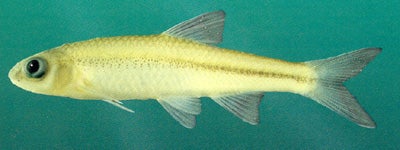CHANNEL SHINER
SCIENTIFIC NAME: Notropis wickliffi
CHARACTERISTICS: The channel shiner, which resembles the mimic and Cahaba shiners, has a slender body form and a broad rounded snout extending slightly beyond the mouth. At the front of the narrow lateral line, the pores look as though they have been stitched together by the dark melanophores located above and below each pore. On the peduncle, the lateral line is well developed, expanding ventrally into a lobed tail spot that extends onto the rays of the caudal fin. The proposal stripe is nonexistent or only lightly pigmented. Scales on the back and caudal peduncle are well outlined with pigment. Breeding colors do not develop. Notropis wickliffi is similar to and occurs sympatrically with the mimic shiner, N. volucellus, in the Tennessee River; pigmentation of the scales on the dorsal peduncle distinguishes the two. In N. wickliffi these scales are uniformly pigmented, whereas in N. volucellus they are more heavily pigmented posteriorly (Mayden and Kuhajda, 1989). Mayden and Kuhajda (1989) assign N. cahabae as the closest relative to N. wickliffi, formerly subspecies on N. volucellus, deserves species status. We concur with Trautman, since Alabama populations of wickliffi are distinguishable from N. volucellus, and we follow his recommendation as recognized by Robins et al. (1991).
ADULT SIZE: 1.6 to 3 in (40 to 75 mm)
DISTRIBUTION: Notropis wickliffi is found throughout the lower Mississippi basin in main river channels. Our limited collections come from the main channels of the Tennessee River, Bear Creek, and the Paint Rock River. Additional sampling will likely reveal a greater range in Alabama.
HABITAT AND BIOLOGY: The channel shiner almost exclusively inhabits large rivers and streams, preferring backwaters and pools with little current. Trautman (1981) reports this species as also inhabiting swift currents below dams and being somewhat tolerant of turbid conditions. Little is known about its biology, but spawning is presumed to occur from late May to August in Alabama, as indicated for Tennessee populations (Etnier and Starnes, 1993).
ORIGINAL DESCRIPTION: The channel shiner was described by Trautman in 1981.
ETYMOLOGY:
Notropis means keeled back.
Wickliffi means in honor of Edward L. Wickliff, a colleague of Milton Trautman, who described the species.
The copyrighted information above is from Fishes of Alabama and the Mobile Basin.






